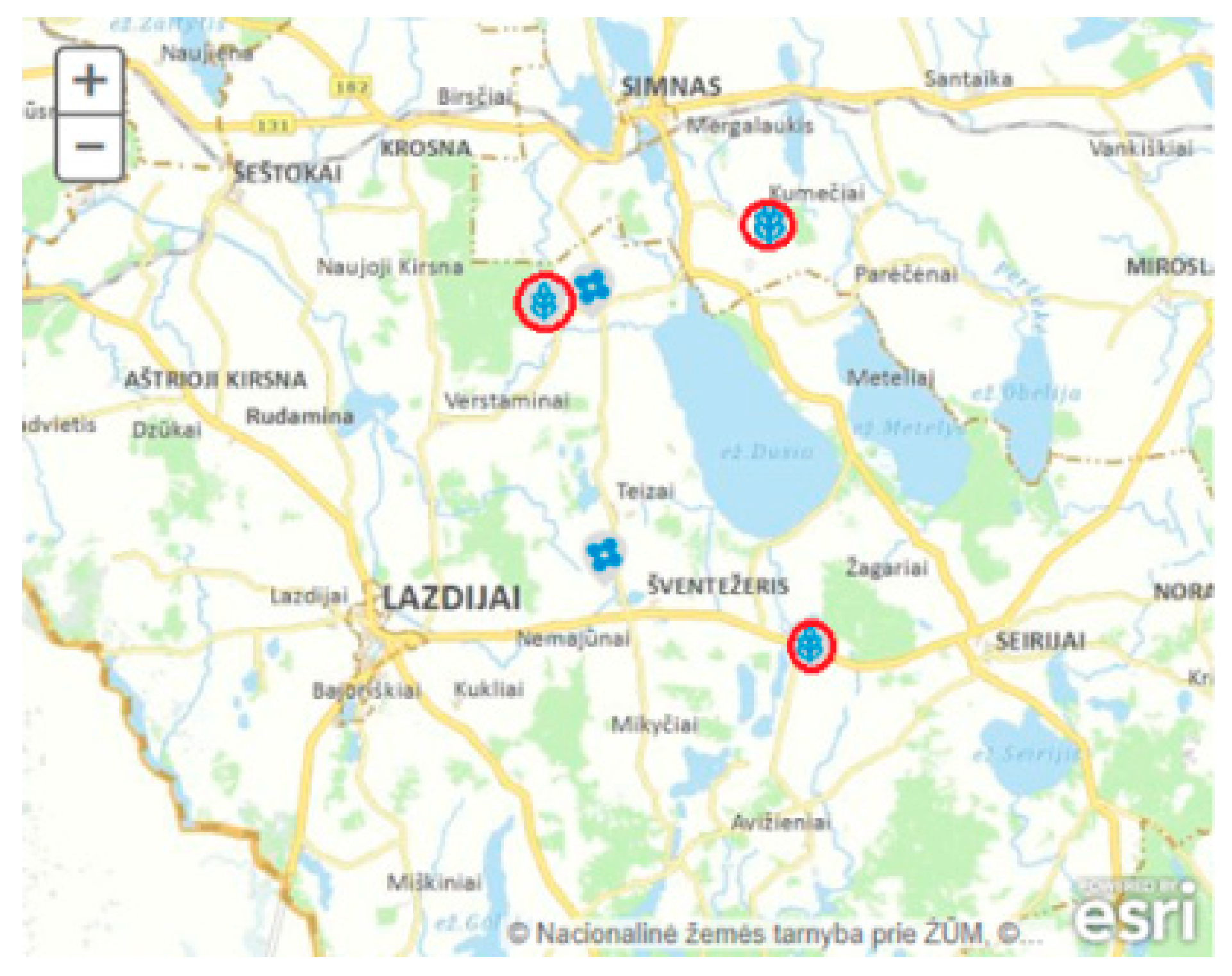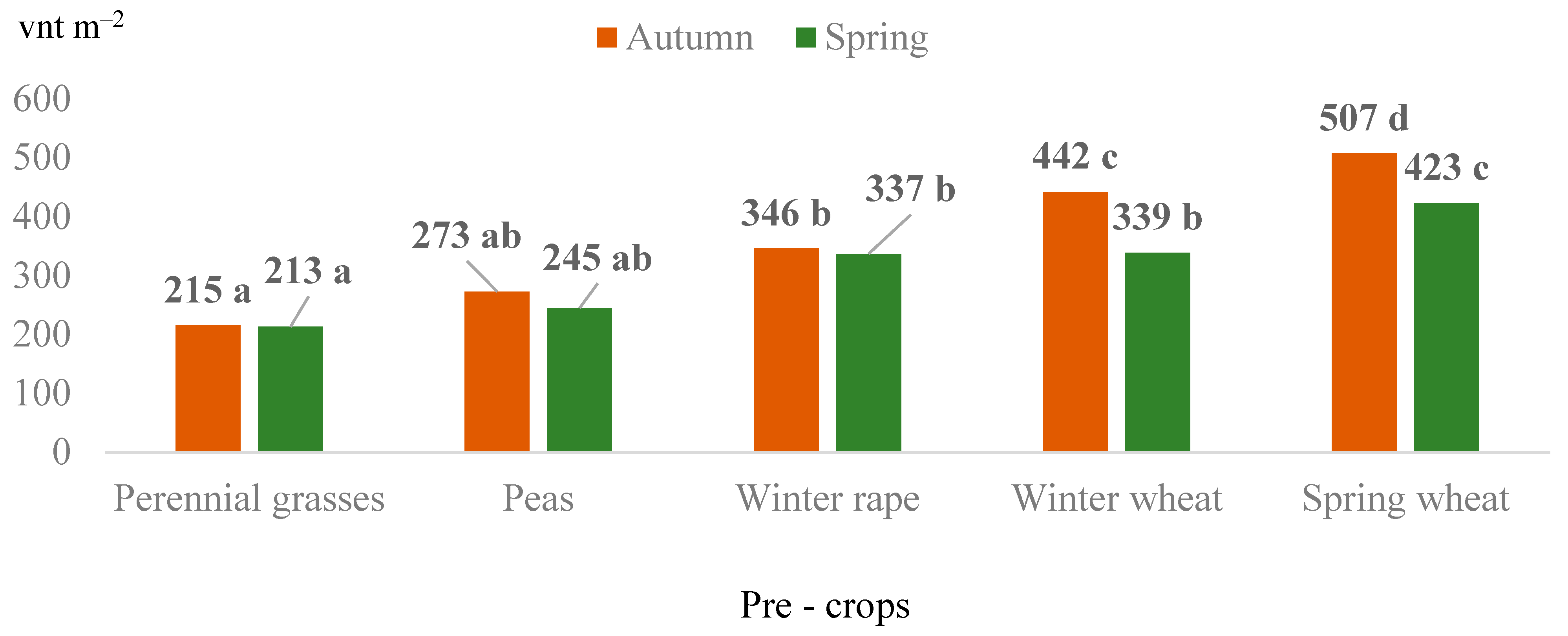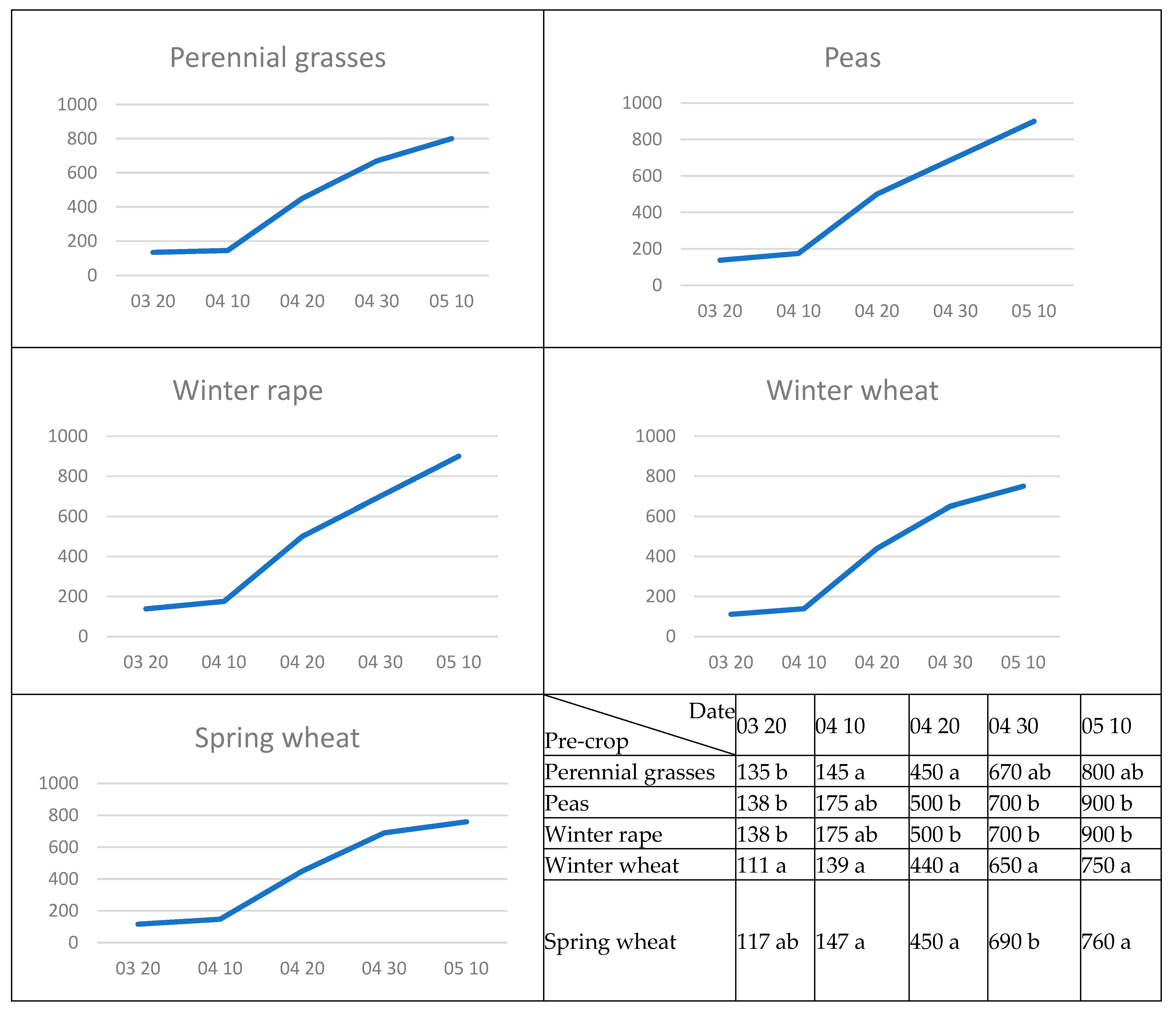1. Introduction
Wheat is one of the main cereal crops worldwide [
1,
2]. Additionally, wheat is the most-grown cereal crop, with over 220 million hectares planted annually [
3]. The main variety of grain cultivated is
T. aestivum, occupying 90% of all wheat areas. The remaining 10% is composed of
T. durum and
T. spelta [
4]. Winter wheat (
Triticum aestivum L., 2n = 6x = 42, AABBBD) is a naturally formed allohexaploid species., having seven homoeologous chromosome groups [
5]. Since wheat farming is relatively easy and suitable for mechanization, farmers often choose to cultivate these crops. A significant factor in increasing wheat productivity is the variety [
6]. The replacement of old varieties with new, more productive, competitive ones, characterized by wide agro-ecological adaptability and enhanced traits for adapting to adverse environmental conditions, better suited to specific soil and climate conditions, and higher levels of agricultural technology, is one of the best ways to obtain large quantities of high-quality grain [
7]. With the change of the global climate, the risk of freeze damage to wheat cultivation has increased. In recent years, with the comprehensive research on the freeze resistance of wheat, especially the development of genetic engineering technologies, the research on the freeze resistance of wheat has made great progress [
8]. Wang et al. (2024) found that the chlorophyll, soluble sugar, soluble protein, and free proline contents of various winter wheat varieties were positively correlated with cold resistance, while the malondialdehyde content was negatively correlated with cold. Five physiological parameters can be used as physiological indicators for breeding cold-resistant varieties [
9]. Currently, there are more than 460 winter wheat varieties registered in the State Register of Plant Varieties [
10].
‘Skagen’ is the most popular variety in the Baltic region. It was registered in Lithuania 12 years ago. The ‘Skagen’ variety is characterized by high and stable yields, excellent spring emergence, and good resistance to many foliar diseases [
11,
12].
According to Šuliauskas [
13], winter wheat is best sown after peas, beans, winter rape, and spring rape. It also thrives when sown after spring wheat, whose pre-crop is winter rape. According to Romaneckas [
14], winter wheat is considered a soil-depleting agricultural crop, and if sown after spring wheat, it may become susceptible to root diseases. Therefore, from a crop rotation perspective, the most suitable pre-crops for wheat are soil-improving plants such as legumes and perennial grasses. According to data from the Lithuanian Institute of Agriculture, spring barley is a better pre-crop for reducing weediness in winter wheat than peas, winter rape, and winter wheat. The number of plants that did not overwinter was determined.
Temperature and precipitation are the major weather characteristics that contribute to crop growth in the North in general and the overwintering capacity of rye and wheat when grown in northern European conditions [
15,
16]. It is projected that the climate will continue to become warmer and the growing season longer, but the increases in temperatures will occur mostly outside the growing season, during autumn and winter [
17,
18,
19] Wheat freezing occurs when the temperature drops below 0 °C [
20], along with various freeze injuries, including sudden temperature drops at the beginning of winter, prolonged cold in winter, drought and freezing, freezing, and warming up in early spring [
21]. Freezing damage can disrupt plant physiological and metabolic processes, such as water metabolism, mineral nutrition, photosynthesis, respiration, and general metabolism [
22]. Freezing damage causes water to freeze inside and outside the cell, and these ice crystals penetrate the cell walls, causing cell dehydration and death.
Osmotic stress has been shown to be a dominant factor affecting the ability of winter wheat varieties to survive winter [
23,
24].
Low temperature stress can pose a serious threat to plants throughout their life cycle and seriously affect crop yield and quality. Therefore, it is urgent to identify effective, sustainable, and environmentally friendly practices that can reduce the negative effects of low temperature on plants and improve crop performance [
25].
Accumulation of reactive oxygen and abiotic free radicals occurs in frozen damaged plants, which damage the internal environment and membrane system of cells, even causing leaf withering and necrosis/death [
26]. Due to all these factors, wheat does not survive smoothly. Freezing damage is an agricultural meteorological disaster that can occur in winter and early spring, causing plant tissues to dry out and freeze, thus losing physiological activity. This ultimately can lead to plant damage or even death [
20]. Several freezing damage studies have been conducted [
27,
28]. Meng et al. [
29] determined the freezing damage indices of winter wheat overwintering in northern China using the principal component method.
The aim of the study is to determine the influence of different pre-sowing treatments on the survival of the winter wheat variety ‘Skagen’ in Albeluvisol soils as winters warm and precipitation increases in autumn and winter. The main objectives are to determine weediness after the application of different pre-sowing treatments to winter wheat and to assess crop viability after plant vegetation renewal.
2. Materials and Methods
2.1. Experimental Design and Agricultural Practices
During the study, three different locations in Lithuania with different pre-crops were selected (
Figure 1). The experimental sites were chosen so that they were not far from each other due to climatic conditions and soil type. Fields of the winter wheat (
Triticum aestivum) variety ‘Skagen’ from farms in the Lazdijai district were chosen for the experiment. The experiment was conducted from 2017 to 2018.
The farms are intensive production ones, employing crop rotation: winter wheat (
Triticum aestivum), winter rape (
Brassica napus), and peas (
Pisum sativum) (
Table 1).
The soil tillage in all treatments was uniform—deep plowing (20–25 cm), soil cultivation, fertilization, and sowing (
Table 2). The preparation of winter wheat for wintering was conducted in all farms on November 25th. The seed rate and sowing depth were chosen by determining the economic value of seeds is as follows [
30]:
To determine the economic value, it is necessary to know the germination and cleanliness of the seeds. For example, the germination rate of the available seeds is 87 percent, and the purity is 99.5 percent. We calculate [
31]:
Next, we calculate the seed rate by physical weight, in kilograms [
31]:
For example, we are calculating the sowing rate for spring wheat, and the planned sowing rate is 5 million sprouted seeds per hectare. The mass of 1000 seeds is 45.4 g [
31].
For successful germination, crops must be sown to a depth within the physiological tolerance of the seed (
Table 3). For wheat, it is generally considered to be 30–50 mm; for lupins, it is 25 mm, and for field peas, it is 30–50 mm [
32].
The plant condition was assessed at 10-day intervals. The soil type was Albeluvisol. The assessment of winter plant conditions in both farms was conducted on April 15th.
During the study, the selected variants were conducted in three replications, with the size of the experimental plot being 30 m
2 (10 m in length and 3 m in width). Soil samples were taken using an agrochemical soil sampling auger (Ø 20 mm) at linear EPV spacing. Samples were taken from a depth of 0–25 cm. This depth was chosen due to the main freeze risk and main nutrients in this soil layer (
Figure 2). This sampling depth was chosen because it is the main layer that contains nutrients for plant roots, which are just beginning to grow. Another main reason freeze is damaging to roots in this soil layer is the risk of uprooting or damaging the plants’ water vessels.
The trajectory line was formed by the letters X and W. In each replication of the variant, 15 soil samples were taken, forming a total of 250 g of soil sample. Soil chemical properties were determined (
Table 4).
During the study, at the beginning of plant vegetation, when the growth stage BBCH 29–30 was reached, the variation of chlorophyll content in leaves was assessed. The measurement was made on the two leaves from the top of the main stem of the plant. Soil temperature was measured using an electronic thermometer IQ 150 in the plant root growth zone. Measurements were taken at 10-day intervals on April 1st, 10th, and 20th.
An electronic chlorophyll meter CM 1000 was used to determine chlorophyll content. Measurements were taken at 10-day intervals on April 1st, 10th, and 20th.
The density of winter wheat crops was evaluated. In permanent accounting plots with an area of 30 m2 on April 15th, all surviving plants were counted in all variants.
2.2. Meteorological Conditions
Meteorological conditions are one of the main factors influencing the winter hardiness of plants. Plants that manage to grow 3–4 tillers before winter are the best suited for wintering. Prolonged severe frosts and temperature fluctuations can hurt crops. After freezing weather, water in the plants can freeze, leading to vitrification. This process occurs when the temperature suddenly drops to −20 °C. Sudden warming can be devastating for plants [
34].
In September 2017, the average air temperature ranged from 12.5 to 14.7 °C (0.5–1.5 °C higher than the standard climate norm for the period of 1981–2010 (hereinafter referred to as SCN). The highest air temperature at the beginning of the month rose to 21–25 °C. The lowest air temperature in late September dropped in many places to 1–4 °C (
Table 5). During September, precipitation in most parts of Lithuania ranged from 90 to 190 mm (1.5 to 2.5 times the SCN).
In October 2017, the average air temperature ranged from 6.1 to 9.9 °C (close to the SCN in many regions). The highest air temperature in the middle of the month rose to 14–20 °C. The lowest air temperature in many places dropped to 0–4 °C. The weather was very rainy. In October, precipitation in most parts of Lithuania ranged from 80 to 125 mm (1.5 to 2 times the SCN).
In November 2017, the average air temperature ranged from 2.5 to 5.8 °C (1.7–2.4 °C higher than the SCN in many areas). The highest air temperature rose to 9–11 °C. The lowest air temperature dropped in many areas to −1 to −3 °C. In December 2017, the average air temperature ranged from 0.0 °C in the eastern regions of the country. The highest air temperature reached 7–10 °C. The lowest air temperature dropped to −1 to −6 °C. In December, precipitation in most parts of Lithuania ranged from 61 to 95 mm (1.3–1.5 times the SCN). A thin (1–10 cm) snow cover was formed almost everywhere in the country on the first day of the month, but by the end of the first month, snow had melted in many areas. In February 2018, the average air temperature ranged from −4.3 to −7.4 °C (2–3.5 °C lower than the SCN). The highest air temperature rose to 1–4 °C. The lowest air temperature dropped in many areas to −19 to −25 °C. In February, precipitation in most parts of Lithuania ranged from 21 to 40 mm (55–90% of the SCN). There was no frost in the Lazdijai region. In March 2018, the average air temperature ranged from −1.0 to −2.8 °C (2.2–2.8 °C lower than the standard climate norm). The highest air temperature rose to 8–11 °C. The lowest air temperature dropped in many areas to −15 to −20 °C (
Table 5). In April 2018, the average air temperature ranged from 8.1 to 11.1 °C (positive anomaly of 2–3.6 °C). The highest air temperature reached 22–27 °C this month. The lowest air temperature dropped in many areas to −1 to −4 °C, with frost observed on several nights towards the end of the month—the temperature on the soil surface dropped to −1 to −7 °C. In most parts of the country, precipitation ranged from 40 to 70 mm (1.2–2.3 times the SCN). The soil remained frozen longer than usual, but thawed intermittently—sometimes frozen, sometimes thawed. Frost persisted at the beginning of the month, but by April 10th, the soils had thawed everywhere. In May 2018, the average air temperature ranged from 15.1 to 17.5 °C (positive anomaly of 2.4–4.8 °C). It was the hottest May since 1961: The previous highest average air temperature in Lithuania was 15.4 °C (in 1993 and 2013), but this year, it was 1 degree higher (16.4 °C). New heat records for May 3rd and 29th were set in Lithuania, and on the 30th, the record for the entire month of May reached 32.7 °C. Precipitation in May was lower than usual: In almost all of southern Lithuania and parts of the northern and western regions, it ranged from 7 to 25 mm (up to 0.5 times the SCN) (
Table 5).
In September and October, the precipitation amount was more than twice as high compared to the long-term average of precipitation. Such a high amount of precipitation must have made it difficult for plants to start growing due to a possible lack of oxygen in the vascular system (
Table 6).
November precipitation (50.0 mm) was in line with the long-term average, while December precipitation was 36.1 mm more than the usual in December. February precipitation was 19.1 mm less than the long-term average. In the spring period from March to May, precipitation was 71 mm, which was 50.64% less than the long-term average in the spring period.
2.3. Statistical Analysis
During the study, the data for the years were processed using a one-factor analysis of variance (ANOVA) method, using the computer program ANOVA from the SYSTAT 12 software package. The probability level of differences among all the treatments was determined using the LSD test [
35].
4. Discussion
Pre-sowing crops have had a positive effect on wheat yields. The lowest cereal yields were observed under conditions without pre-crops and no planting of beech. The brassica family plants grown in these experiments showed a positive effect on grain yield, harvest index, number of seeds per spike, and number of spines per spike. Therefore, it can be concluded that using brassica family plants can improve the physical conditions of the soil, increase the organic matter content, and have a positive effect on subsequent yield [
41].
Plant development depends on ambient and soil temperature, soil moisture content, and fertility. Temperature and humidity are the factors that most determine the intensity of soil gas and water vapor flux. They interact to alter the rate of decomposition of organic matter and other biological and biochemical processes in the soil [
35,
36]. Peltonen-Sainio et al. [
42] conducted a study related to the overwintering of cereals and the amount of precipitation in autumn. The research team stated that the severity of overwintering damage varies greatly from year to year, and the study failed to determine the dependence on the wheat variety and overwintering. However, it was observed that overwintering damage may increase due to climate change, which is currently increased by the large amount of autumn precipitation. In particular, fluctuating conditions for wheat prevent wintering in the current growing regions, and this is unlikely to change in the future, but climate change may worsen the situation even more. Žekonienė et al. [
43] found that the overwintering of winter wheat is greatly affected by the time of early spring, when the frost has not yet completely gone, spring frosts begin, and, as a result, the upper soil layer begins to move, weak wheat roots are broken, and their seedlings are uprooted. Then many plants die. At the same time, it depends on the type of soil and how much organic matter it contains. I. Pranckietienė [
44] states that the overwintering of plants largely depends on the applied fertilization in the autumn period. Overwintering is related to the distribution of proteins, carbohydrates, organic compounds, and the enzyme superoxide dismutase in plants. The growth of winter crops is prolonged during the growing season. According to Šuliauskas [
13], winter wheat has different air temperature requirements as it grows and develops. For example, seeds germinate at 2–3 °C and germinate at 5–8 °C. The optimum germination temperature is 16–20 °C. The above-ground part of the plant starts to grow at temperatures of at least 4–6 °C. The optimum air temperature for initial growth is 14–16 °C. The stem and inflorescences start to form internally at a temperature of 6–10 °C. The flowering and fruiting of wheat is possible at 12–14 °C. The optimum temperature for grain maturation is 18–22 °C.









